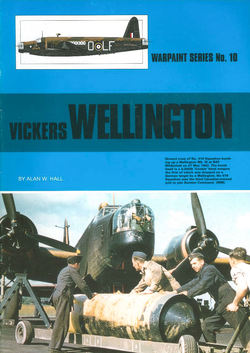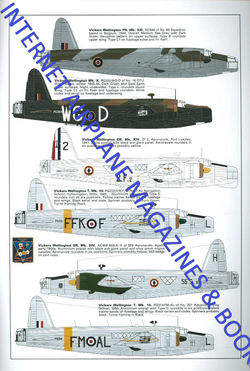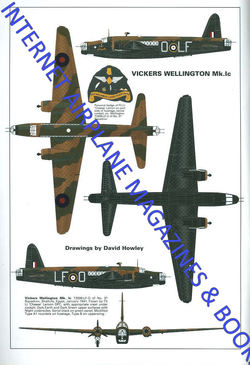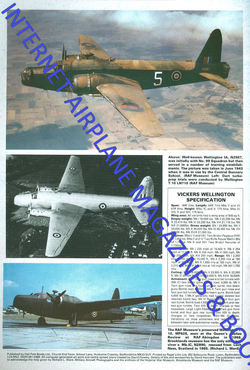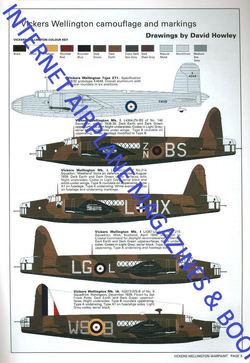WARPAINT 10 WW2 VICKERS
WELLINGTON RAF BOMBER COMMAND COASTAL COMMAND DWI GR MIDDLE EAST SEAC FAR EAST
TRANSPORT COMMAND FLEET AIR ARM OUT GREECE FRENCH AERONAVALE
ALAN W. HALL
WARPAINT SERIES
SOFTBOUND BOOK
***LIKE NEW CONDITION***
INTRODUCTION (BARNES WALLIS, GEODETIC
STRUCTURE, RAF BOMBER COMMAND, BRISTOL PEGASUS XVII RADIAL ENGINE)
WELLINGTON Mk.I
WELLINGTON Mk.IA
WELLINGTON Mk.IB
WELLINGTON Mk.IC
WELLINGTON DWI (DIRECTIONAL WIRELESS
INSTALLATION) MINE WARFARE
WELLINGTON GR.Mk.VIII TORPEDO BOMBER,
GR.MkVIII ANTI-SUBMARINE, LEIGH LIGHT, NOSE DEVELOPMENTS, FUSELAGE ANTENNA,
WING AERIALS
WELLINGTON Mk.II
WELLINGTON Mk.III (HERCULES RADIAL
ENGINE)
WELLINGTON Mk.IV (PRATT & WHITNEY
TWIN WASP RADIAL ENGINE)
WELLINGTON Mk.V AND Mk.VI
WELLINGTON Mk.X
WELLINGTON Mk.XI
WELLINGTON Mk.XII ANTI-SUBMARINE
WELLINGTON GR.Mk.XIII
WELLINGTON GR.Mk.XIV
WELLINGTON C Mk.XV TRANSPORT
WELLINGTON C Mk.XVI TRANSPORT
WELLINGTON T Mk.XVII TRAINER
WELLINGTON T Mk.XVIII TRAINER
WELLINGTON T Mk.XIX
WARWICK
PHONEY WAR DAYLIGHT RAIDS
THE BATTLE OF HELIGOLAND BIGHT
MEDITERRANEAN THEATRE
LORENZ HORIZONTAL RECEIVING AERIAL
FUSELAGE WINDOW CHANGES
--------------------------------------------------------------------------------------------------------------------------
Additional Information from Internet Encyclopedia
The Vickers Wellington was a British twin-engined, long range medium bomber designed in the mid-1930s at Brooklands in Weybridge,
Surrey, by Vickers-Armstrongs '
Chief Designer, Rex Pierson in response to specification B.9/32.
Issued in the middle of 1932, this called for a twin-engined day bomber of
higher performance than any previous design. It was widely used as a night bomber in the early years of the Second World War, before being
superseded as a bomber by the larger four-engined "heavies" such as
the Avro Lancaster.
The Wellington continued to serve throughout the war in
other duties, particularly as an anti-submarine
aircraft. It was the only British bomber to be produced for the duration of the
war and was still first-line equipment when the war ended. The Wellington was
one of two bombers named after Arthur
Wellesley, 1st Duke of Wellington, the other being the Vickers Wellesley.
The Wellington used geodesic construction,
devised by Barnes Wallis inspired by his work on airships, and previously used to build the single-engined Wellesley light
bomber. The fuselage was built from 1650 elements, consisting of aluminium
alloy (duralumin) W-beams formed into a
framework. Wooden battens screwed to the aluminium were covered with Irish linen, which, treated with layers of dope,
formed the outer skin of the aircraft. The metal lattice gave the structure
strength, because any one stringer could support some of the weight even from
the opposite side of the aircraft. Blowing out one side's beams would still
leave the aircraft as a whole intact; as a result, Wellingtons with huge areas
of framework missing returned home when other types would not have survived;
the dramatic effect was enhanced by the doped fabric skin burning off, leaving
the naked frames exposed.
The geodesic structure was strong and
light for its size, which gave the Wellington a load- and range- to-power-ratio
advantage over similar aircraft, without sacrificing robustness or the
protection of armour plate or self-sealing
fuel tanks. The
construction took longer to build than other designs using monocoque construction
and it was difficult to cut holes in the fuselage to provide access or
equipment fixtures. The Leigh light was deployed through the mounting for the absent FN9 ventral
turret. Nonetheless, in the late 1930s
Vickers built Wellingtons at one a day at Weybridge and 50 a month at Broughton in North Wales. Peak wartime production in 1942 saw monthly rates of 70
at Weybridge, 130
at Broughton and 102 at Blackpool
The Wellington was built in 16 variants
plus two training conversions after the war. The prototype, serial K4049
designed to Ministry
Specification B.9/32, first flew as a Type 271 (initially
named Crecy) from Brooklands on 15 June 1936, with chief test pilot Joseph Summers as pilot. After many design changes, it was accepted on
15 August 1936 for production with the name Wellington. The first model was the Wellington Mark I, powered by a pair of 1,050 hp
(780 kW) Bristol
Pegasus engines, of which 180 were built, 150 for the Royal Air Force and 30 for the Royal
New Zealand Air Force (which were transferred to the RAF on the outbreak of war
and used by 75 Squadron). The Mark I entered service with 9 Squadron in October 1938. Improvements to the turrets resulted in
183 Mark IA Wellingtons,
which equipped the RAF
Bomber Command heavy
bomber squadrons at the outbreak of war. The Wellington was
initially outnumbered by the Handley
Page Hampden and the Armstrong
Whitworth Whitley but outlasted them in service. The number of Wellingtons
built totalled 11,461 of all versions, the last rolled out on 13 October 1945.
A shadow factory was set up in 1938 especially to make wings for the Wellington
Bomber at Trecenydd Caerphilly South Wales operated by Welsh Metal Industries
Ltd, now Trecenydd Business Park.
The first RAF bombing attack of the war
was made by Wellingtons of No. 9 and No. 149 Squadron, with Bristol
Blenheims, on German shipping on 4
September 1939. During this raid, two Wellingtons became the first aircraft
shot down on the Western Front. Numbers 9, 37 and 149 Squadrons saw action on 18
December 1939 on a mission against German shipping on the Schillig Roads and Wilhelmshaven. Luftwaffe fighters destroyed 12 of the bombers and badly damaged three
others, thus highlighting the aircraft's vulnerability to attacking fighters,
having neither self-sealing fuel tanks nor sufficient defensive armament. In
particular, while the aircraft's nose and tail turrets protected against
attacks from the front and rear, the Wellington had no defences against attacks
from the beam and above, as it had not been believed that such attacks were
possible owing to the high speed of aircraft involved. As a consequence, Wellingtons were
switched to night operations and participated in the first night raid on Berlin on 25 August 1940. In the First 1,000 bomber raid, on 30
May 1942, 599 out of 1,046 aircraft were Wellingtons (101 of them were flown by Polish aircrews). With Bomber Command, Wellingtons flew 47,409
operations, dropped 41,823 tons (37,941 tonnes) of bombs and lost
1,332 aircraft in action.
Coastal Command Wellingtons carried out anti-submarine
duties and sank their first enemy vessel on 6 July 1942. DWI versions fitted
with a 48 ft (14.63 m) diameter metal hoop were used for exploding
enemy mines by generating a powerful magnetic field as it passed over them. In
1944, Wellingtons of Coastal Command were deployed to Greece, and performed various support
duties during the RAF intervention in the Greek
Civil War. A few Wellingtons were operated by the Hellenic Air Force.
While the Wellington was superseded in the European Theatre, it remained in
operational service for much of the war in the Middle East and in 1942, Wellingtons based in India became the RAF's first long-range
bomber operating in the Far East.
It was particularly effective with the South
African Air Force in North Africa. This versatile aircraft
also served in anti-submarine duties with 26
Squadron SAAF based in Takoradi, Gold Coast (now Ghana).
In late 1944, a radar-equipped Wellington XIV from 407
Sqn. RCAF was modified for use by the RAF's Fighter
Interception Unit as what would
now be described as an airborne
early warning and control aircraft. It operated at an altitude of some
4,000 ft (1,219 m) over the North
Sea to control a de Havilland Mosquito and a Bristol Beaufighter fighter intercepting Heinkel He 111 bombers flying from Dutch airbases, and carrying out airborne
launches of the V-1 flying bomb.
The FIU operators on the Wellington would search for the He-111 aircraft
climbing to launch altitude, then direct the Beaufighter to the bomber, while
the Mosquito would attempt to intercept the V-1 if launched.
The Wellington is listed in
the appendix to the novel KG 200 as one flown by the German secret
operations unit KG 200, which
also tested, evaluated and sometimes clandestinely operated captured enemy
aircraft during the Second World War.



